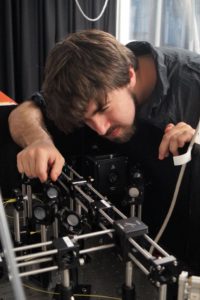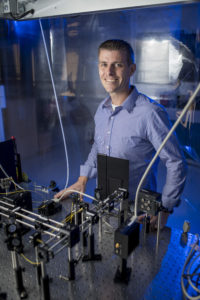
Tom Folland is a postdoctoral researcher in the Caldwell Lab in the School of Engineering at Vanderbilt, where he works on creating optical components for manipulating infrared (thermal) radiation. “Tom is truly an exceptional researcher,” said Joshua Caldwell, associate professor of mechanical and electrical engineering, and Tom’s primary mentor, “and is without doubt the best postdoc I have observed in 14 years at the Naval Research Laboratory and Vanderbilt.”
Hailing from the University of Manchester in the UK, Tom came to Vanderbilt to work with Caldwell to develop new techniques (exploiting infrared light) to understand the properties of materials and use them to create functional devices. Shortly after arriving, Tom began a collaboration with Richard Haglund, Stevenson Professor of Physics, to explore the behavior of hyperbolic polaritons in two-dimensional hexagonal boron nitride (hBN) crystals coupled to the phase-change material vanadium dioxide (VO2). Hyperbolic polaritons ‘shrink’ infrared light to a scale much smaller than its wavelength, which allows us to image much smaller objects using infrared light.

Vanadium dioxide meanwhile switches reversibly from an insulator to a metal when heated, resulting in significant changes in optical behavior in the infrared between these two phases. By combining these two materials, Tom was able to experimentally observe refraction of hyperbolic polaritons for the first time.
This is a critical discovery that has opened up, for the first time, the general concepts of standard, far-field optics to on-chip, compact, planar systems compatible with semiconductor processing. Moreover, because the reversibility of the phase transition of VO2, this enabled the design of on-chip, reconfigurable optical components. As evidence of this, the work was published in the prestigious journal Nature Communications and is the focus of a patent application. Tom is now developing these concepts further with different materials and creating sensors based on polariton modes. These sensors could take the form of a small detector for pollutants either contained in the air or in liquids, which could be integrated into devices such as mobile phones.

Tom has been able to achieve such excellence in research, while being the primary lead in establishing the experimental capabilities of the Caldwell lab, taking courses at the Center for Teaching and successfully writing proposals. These points illustrate the excellence that he brings to his position and what a successful postdoctoral fellowship looks like. If you are interested in reading more about Tom’s work check out his personal website, or the Caldwell lab.